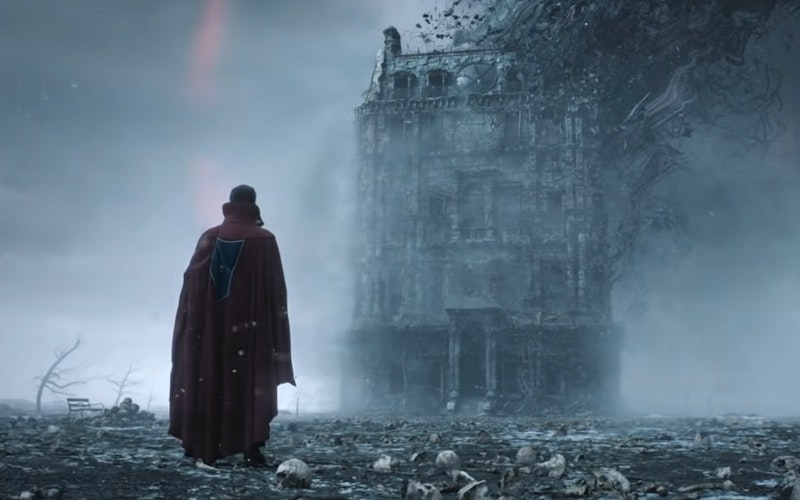
Movies
Fighting Evil with Evil in the Multiverse of Madness
There is no such thing as a secular superhero story.
In such tales, fantastical heroes and villains display powers that transcend the material world and impact their commitment to make the world a better or darker place. These battles of good versus evil align deeply with the story of God, of the Divine equipping and empowering everyday humans to fight against the Dark One. Still, the Marvel Cinematic Universe didn’t fully acknowledge a spiritual realm until 2016’s Doctor Strange. This spiritual quality takes a dark turn in its sequel, Doctor Strange in the Multiverse of Madness.
Directed by Sam Raimi, who made his name with horror films like The Evil Dead before going on to make the Tobey Maguire Spider-Man movies, Multiverse of Madness features demonic phantasms, damned souls, and hints of hell. Wanda Maximoff (Elizabeth Olsen), having turned villainous in the Disney Plus series WandaVision, unleashes a great evil upon the multiverse and it is up to Doctor Strange (Benedict Cumberbatch) to contain it. Good must triumph. However, Multiverse of Madness teaches us that the method by which we fight evil in this world matters a great deal. (Spoilers ahead.)
In this 28th MCU film, Wanda acquires the Book of the Damned and uses its dark magic —called the Darkhold—to enter a different universe, where she can be with alternate versions of the twin sons she conjured, then lost, in WandaVision. Her methods to accomplish this are disastrous. She casts a dark spell and “dream walks,” allowing her body to briefly possess the Wanda variant living on Earth 838. In a bloody horror sequence that feels straight out of the pages of Stephen King’s Carrie, the possessed Wanda becomes a nightmarish creature. Her eyes pool black as she sets herself on a murderous rampage, executing the Avengers that exist in this universe. Her body creepily contorts into position after bones are broken; she doesn’t flinch as blood runs across her face. Evil has come for Wanda’s soul and she gives in to its power, pursuing her elusive dream of recreating her family. In the meantime, incursions—universes colliding into each other—and the deaths of millions loom large.
Doctor Strange is tasked to intervene, but how will he stop such a formidable force of evil? In a surprising twist, our hero chooses to fight evil with evil. Instead of casting good spells, the former Sorcerer Supreme believes he can only defeat Wanda using her power against her. He practices the Darkhold and dream walks, using the corpse of one of his own variants, to confront Wanda. When zombie-esque Strange appears, the camera zooms in on his rotted, pale flesh. With teeth half exposed and bulging eyes, he gapes at his frayed fingers and a grotesque smile stretches across his slashed cheeks. In order to fight evil, he has become a nightmare, just like Wanda.
Multiverse of Madness teaches us that the method by which we fight evil in this world matters a great deal.
Watching the film in the theater, I wondered, “Did it have to be this way?” Was choosing to fight evil with evil the best option? Romans 12:21 states, “Do not be overcome by evil, but overcome evil with good.” Followers of Jesus are to fight evil with the word of God. We stand our ground against the dark forces of this world by putting on the armor of God, which includes a belt of truth, a breastplate of righteousness, ready feet with the gospel of peace, a shield of faith, and a helmet of salvation. For followers of Jesus, superhero stories allow us to project our imaginations into a spiritual realm and believe, truly believe, that if we were to walk into battle with a supernatural villain, our only weapon need be scripture itself.
In Multiverse of Madness, perhaps the word of God could have been metaphorically represented by the Book of Vishanti—an ancient book of knowledge and power that could be used by sorcerers. Its white magical spells were supposed to be the antithesis of the Darkhold. Yet, Doctor Strange is unable to acquire this book; it turns to ash in his hands before he is able to wield it.
Instead, Strange brings a swarming horde of the undead under his control and uses them as wings to fly up to Mount Wundagore, where Wanda has launched her attack across the multiverse. Strange’s cloak adorns his head with an array of metallic, skeletal arms, rising in black against a dullish gray sky. Raimi’s influence feels like it's on full display during this scene, with its lightning-fast speed and kinetic composition, as the demonic phantasms swirl both in and around Strange. Eventually Strange defeats Wanda by these supernatural means, but I’m convinced the medium by which he won could have been different.
The end justifies the means in Doctor Strange in the Multiverse of Madness. But as Christians, we know that the journey is just as important as the finish line. We are called to a life of righteousness. When we stand in the face of evil and injustice, we are to take the high road, trusting the Holy Spirit to move within us and lead us down the path we should go.
Topics: Movies